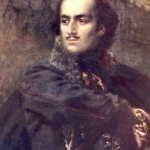“Pulaski has died as he lived, a hero, but an enemy to kings.”
At the eastern end of Freedom Plaza, at 13th Street NW and Pennsylvania Avenue, is the equestrian statue of General Casimir Pulaski. The statue is surrounded by stone benches and office workers can often be found lunching on them, under the nearby trees.

The statue was dedicated in May 1910 along with that of fellow Pole and hero of the American Revolution, Thaddeus Kosciuszko. President William Howard Taft spoke at the dedication that was attended by a full military parade as well as national dignitaries. Taft said of Pulaski, “When he came here, the American army practically had no cavalry, and to him … was turned over the question of the organization of the cavalry force. At Brandywine and at Germantown he showed the mettle that was in him.”
The statue was created by Polish artist Kazimierz Chodziński, who has many renowned works in Europe, but his sculpture of Pulaski is likely his most famous in the United States. The statue rises 15 feet from its pedestal and Pulaski is wearing a Polish Hussar uniform which he wore the three years he fought in the revolution.
Pulaski came to America after fighting unsuccessfully for Polish independence. His father and brothers had died in the conflict and he made his way to France, where he met Benjamin Franklin. Franklin recommended him to George Washington, noting his “courage and bravery.” This was put to the test in the Battle of Brandywine when Pulaski led a charge against the British army during the American retreat, saving the life of Washington. He was commissioned as a general four days later.
In 1778 Pulaski was given the title “Commander of the Horse” and formed what would be called Pulaski’s Legion. The Legion was ordered to South Carolina in 1779, where Pulaski would take part in the Siege of Savannah. Twenty-one days into the siege, the combined French and American forces attacked the city with Pulaski leading the cavalry of both armies. While attempting to rally fleeing cavalry he was mortally wounded by British grape shot and died two days later.

Pulaski is remembered as a hero of the revolution and was granted honorary citizenship in 2009, one of only nine individuals granted that honor. October 11 is General Pulaski Memorial Day, and New York City holds a parade on Fifth Avenue every year on the first Sunday in October in his honor. Ships, towns, and roads in Poland and the United States are named in his honor. Next time you’re in Freedom Plaza, take a moment to appreciate the life of Casimir Pulaski.

Resources used for this article:
https://en.wikipedia.org/wiki/Casimir_Pulaski
https://en.wikipedia.org/wiki/General_Casimir_Pulaski_(statue)
https://archive.org/stream/pulaskislegion00spen/pulaskislegion00spen_djvu.txt
http://explorepahistory.com/odocument.php?docId=1-4-BD



One thought on “Casimir Pulaski”
Comments are closed.